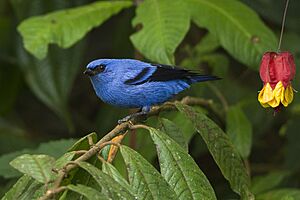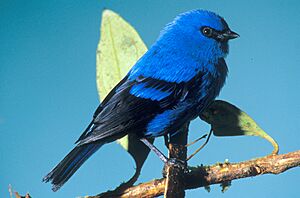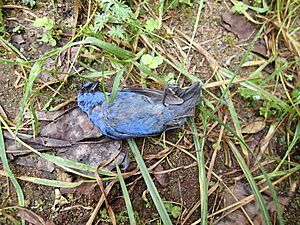Blue-and-black tanager facts for kids
Quick facts for kids Blue-and-black tanager |
|
|---|---|
 |
|
| Conservation status | |
| Scientific classification | |
| Genus: |
Tangara
|
| Species: |
vassorii
|
 |
|
The blue-and-black tanager (Tangara vassorii) is a colorful bird found in the Andes mountains. These birds live in countries like Bolivia, Colombia, Ecuador, Peru, and Venezuela. They prefer high-up places, from 1,500 to 3,500 meters (about 4,900 to 11,500 feet) above sea level. This makes them unique, as they live higher than any other bird in their group, the Tangara species.
Blue-and-black tanagers are about 13 centimeters (5 inches) long and weigh around 18 grams (0.6 ounces). They are mostly bright blue with black faces, wings, and tails. Females look a little less bright than males. They eat fruits and insects, often searching for food with other bird species. They build cup-shaped nests and lay two eggs. The good news is that these birds are not currently in danger of disappearing, but their homes are shrinking due to habitat destruction.
| Top - 0-9 A B C D E F G H I J K L M N O P Q R S T U V W X Y Z |
About the Blue-and-Black Tanager
The blue-and-black tanager was first described in 1840 by a person named Auguste Boissonneau. The name Tangara comes from a word in the Tupi language that means "dancer." The second part of its name, vassorii, honors a French collector named M. Vassor.
This tanager is one of 27 different species in the Tangara group. It's closely related to birds like the spangle-cheeked tanager. Scientists use DNA to understand how these birds are related to each other.
Different Types of Blue-and-Black Tanagers
There are three recognized types, or subspecies, of the blue-and-black tanager. They mostly look a bit different in their feather colors.
- T. v. vassorii: This is the main type. It lives from southern Venezuela to northern Peru.
- T. v. branickii: This type is found from central Peru to Bolivia. It has a dull bluish-green head.
- T. v. atrocoerulea: Sometimes called the spot-bellied tanager, this type lives in the Andes of northern Peru. It's a lighter blue and has black streaks on its chest. Some experts even think this might be a separate species!
What They Look Like
The blue-and-black tanager is a medium-sized bird for its family. It's about 13 centimeters (5 inches) long and weighs around 18 grams (0.6 ounces).
Males and females look a little different, which is called sexual dimorphism. Males are a bright cobalt blue with a black mask around their eyes. Their wing and tail feathers are black with blue edges. Young birds are mostly gray, but they have black wings and tails.
Their beak is quite short compared to other Tangara birds. Their eyes are brown, their beak is black, and their feet are a reddish-gray color.
Sometimes, people might confuse this bird with the masked flowerpiercer. But you can tell them apart by the tanager's brown eye and shorter, thicker beak.
Their Calls and Songs
Blue-and-black tanagers make several sounds. Their calls include a thin, high-pitched tsit or a slightly lower swit. They might also repeat swit-swit-swit or make a hard SWIT-it sound.
Their song is a series of high-pitched notes that lasts about 2 to 3 seconds. It starts slow and then speeds up into a trill, like zieeu-zie-zie-zizizizee. They sing this song every 15 seconds or so.
Where They Live
The blue-and-black tanager lives in the northern and central Andes mountains. You can find them in Bolivia, Colombia, Ecuador, Peru, and Venezuela. They prefer high elevations, between 1,500 and 3,500 meters (about 4,900 to 11,500 feet).
They are the only Tangara species found so high up, often near the tree line where forests start to thin out. They mostly live in mountain evergreen forests, smaller "dwarf" forests, and forests that are growing back after being cut down. They also like the edges of forests and open areas with some trees. They usually stay high up in the treetops, also known as the canopy.
How They Live
Blue-and-black tanagers often join large groups of different bird species when they are looking for food. They usually forage in pairs or small groups of 3 to 6 birds. Sometimes, these mixed-species flocks can have up to 15 blue-and-black tanagers! In Colombia, they are even known as a "nuclear species," meaning they help form and keep these mixed-species flocks together. They are often seen with Iridosornis or Anisognathus species more than other Tangara birds.
What They Eat
The blue-and-black tanager eats both fruits and insects. They especially love fruit from plants in the Miconia group. They are very active when they look for food, constantly moving through the leaves and branches.
They search for insects by hopping on mossy branches and checking under leaves, moss, and small plants called bromeliads. When they eat fruit, they quickly reach out to grab it, then sit upright to enjoy their meal.
How They Raise Their Young
Blue-and-black tanagers breed from February to August. They build cup-shaped nests using moss and small roots. The outside of the nest is often covered with Chusquea bamboo leaves, and the inside is lined with soft fibers and animal hair.
Nests have been found in May and June. They are about 8 centimeters (3 inches) wide and 7 centimeters (2.7 inches) tall on the outside. Inside, they are about 6 centimeters (2.3 inches) wide and 3 centimeters (1.2 inches) deep. These nests are usually placed about 3.8 to 5 meters (12 to 16 feet) high in small trees.
They lay two eggs at a time. The eggs are pale blue with cinnamon-colored spots. Young birds begging for food have been seen in January, and young birds that have just learned to fly (called fledglings) have been seen in May.
Their Conservation Status
The blue-and-black tanager is listed as a species of least concern by the International Union for Conservation of Nature (IUCN). This means that, for now, they are not considered to be in danger of extinction. This is because they live across a large area, are fairly common, and their numbers haven't dropped significantly.
Even the atrocoerulea subspecies, which some consider a separate species, is also listed as least concern for the same reasons. However, these beautiful birds are still threatened by habitat destruction, which means their forest homes are being cut down or changed. This is a challenge that could affect their populations in the future.





